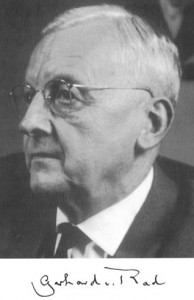17 Ah Lord God! It is you who made the heavens and the earth by your great power and by your outstretched arm! Nothing is too hard for you. [Jeremiah 32:17, NRSV]
Surveying the major currents in interpreting biblical sources on creation, one is bound to meet not only passages that focus specifically on creation, but also a diverse range of verses on other topics that also touch on creation. What all this suggests is that it is not appropriate to speak of a systematic theology of creation in the Bible; rather, there is a prominent biblical creation faith:
- a faith that influences the creation doctrine of the Christian tradition,
- a faith that insists that God is the origin, ground, and goal of the world and everything in it, and
- a faith that continues to be addressed by theologians.
A prior question quickly sneaks up on us: What is the Bible all about? The works of two major figures in the field of Old Testament studies are representative of the two principal lines of interpretation in the historical development of understanding of the Old Testament.
The first figure is Gerhard von Rad [d. 1971]. In 1936, von Rad forcefully argued that salvation history is the most important hermeneutical category for interpreting the biblical faith. His thesis, which reigned in the biblical scholarly world for a few decades in the twentieth century, is that the Old Testament has no independent theology of creation, and that creation theology is at best subordinated to human redemption in biblical thought. Von Rad’s position enjoyed wide acceptance by a generation of scholars due to the hermeneutical presuppositions of his day, based principally on the philosophy of logic. As a result of the influence of von Rad, creation has until recent years been treated as a secondary topic to salvation.
Claus Westermann Enuma Elish on stone tablets.
Von Rad’s position held sway until the second major figure in Old Testament studies came along, in the person of Claus Westermann [d. 2000]. Scholars of Westermann’s generation no longer subscribed to those presuppositions popular with Von Rad’s. Westermann found no disparity between the scientific and the theological explanations of the origins of the world. More importantly, he saw the Old Testament as having something seriously important to say about the Creator and His creation. With that change of perspective, crucial conclusions began to draw a much-deserved attention:
- creation must not be subsumed under soteriology;
- otherwise, we fail to read accurately what is being said in the Bible about the activity of God; and
- even though Salvation History is a very important subject for all Christians to study, we ignore at our serious peril the study of the doctrine of Creation which is prior to and quite capable of holding its own, and independent of Salvation History.
Von Rad’s argument has in recent decades been disputed by many who conclude from the biblical data, that creation of the world was an intimate part of ancient Israel’s concerns. The early 20th century witnessed a strong advance in scientific discoveries. This militated against a theology that places creation faith in the foreground. In the later part of the 20th century, however, the hermeneutical key shifted. Claus Westermann’s alternative hermeneutical approach that the creation texts like Genesis have a self-contained expression of faith best understood through an analysis of their relationship to the myths of the ancient Near East, attracted much interest and support.
Composed between 6 – 10 centuries B.C., the Genesis creation texts were not intended to answer the scientific question of how the world came to be, but to proclaim the relationship of God to reality as Creator to creation – in other words, the question of why the world exists.
The intended readers of the time did not base their views of the universe on critical use of empirical data. Instead, their views were imaginative, concrete, pictorial, even poetic.
In this light, Genesis 1 has been seen as a protest against the devastating experience of the Babylonian exile (6th century B.C.), as well as a protest against the then accepted notion of creation. In that context, Genesis 1 aimed at asserting a belief in God’s power over chaos. It was never intended to give a final, single explanation of how God created the earth.
So in the Book of Genesis, different presentations prevailed – Genesis 1-2 have 2 different creation narratives written in different centuries, each addressing issues, concerns and needs of its peculiar situation. Clearly, each phase of Israel’s faith-reflection expressed its understanding of creation in a way intelligible to itself.
The major intent is to assert not the history of primordial times, but an affirmation of faith in God to put things right.
- Through God’s word alone, an orderly world is created.
- Furthermore, God’s work of creation is arranged into a network of sentences whose succession follows a pattern of fulfillment of a word of command given by God.
- What we see is a creation command because it is unlike God’s command in history directed to a person (e.g., Abraham), or mediator (e.g., Moses).
Additionally, emphasis on creatureliness of heavenly bodies serves to exalt Israel’s God as Creator compared with creation stories from Israel’s neighbours. The purpose of the first creation story is to praise God. The narrative with its seven-day successive stages of creative activity culminating in a day of Sabbath rest displays a movement that transcends the works of creation towards celebration. Creation, it suggests, has a goal and the goal is doxology. We are made to praise our Maker, and in so praising, we remember our creatureliness, our limitations, our interdependence.
A note on Enuma Elish
Enuma Elish was a Babylonian creation myth named after its opening words. Babylon was an Akkadian city-state founded in 1867 BC by an Amorite dynasty of ancient Mesopotamia, a stretch of land between Rive Tigris and the Euphrates. Today, its remains are found in the Babylon Province, some 85 kilometres south of Bagdad, Iraq. Israel was in Babylonian exile in the 6th century B.C..
Enuma Elish which dates back to the 12th century B.C., has about 1,000 lines, recorded on 7 clay tablets found in the ruins of a palace. This epic poem is one of the most important sources for understanding Babylonian worldview, centered on the supremacy of Marduk and the creation of human kind for service of the gods. Its primary original purpose, however, is not an exposition of theology or theogony, but the elevation of Marduk, the chief god of Babylon, above other Mesopotamian gods.
Even though some see parallels between Enuma Elish and the first creation narrative in Genesis 1, the differences are substantively too great.
Whereas in the Babylonian Enuma Elish the purpose of human creation is the service of the gods, in Gen 1:26-31, humans are made in the image of God. As the crowning glory of God, humans are vested with dual relationship – one to God and the other to earthly co-inhabitants. As creatures, humans image God and have a special purpose within the plan of creation. They act as God’s representatives and are charged with dominion over other creatures. Clearly, Genesis 1 poses no opposition between a scientific and a theological explanation of the origin of the world and of humanity. It is not a scientific text, but it is certainly not intended to preclude science. In fact, it demythologizes heavens and earth, making them available to human research.
The 2nd creation story (Genesis 2:4b-3:24) is again a statement that is theological and anthropological. It is not concerned with providing answers to questions of cosmogony. It is an etiology – a story of symbolism that seeks to explain the causes for the present condition of the people. It involves the experience of goodness and happy relationship with God, as well as experiences of sin and estrangement from God. As well as being a creation narrative, we find here a primeval narrative of crime and punishment.
Westermann contends that the creation of humankind is complete only when woman is created and the man and the woman are together. Genesis reflects a stage of civilization that was aware of the great importance of the role of women in the existence of humankind. Unique among the creation myths of the whole of the ancient Near East, in its appreciation of the meaning of woman, Gen 2 preaches that human existence is a partnership of man and woman.
In fact, there is a way to show that in the schema of the 2nd creation story, women are intended by God to be superior, and more important (see post No.25 of 1/2/2011 titled “Are Men more Important?” on this website). In any case, we would do well to embrace the fundamental dignity of all human persons and of gender-equality (see post No.29 of 1/4/2011 titled “The Human Person Adequately Considered” [HPAC]).
Phyllis Trible argues that the creation of the woman is necessary to the completion of creation. In Genesis 2, the man is not depicted as either prior or superior to the woman. His sexual identity depends on her even as hers depends upon him. For both of them, sexuality originates in the one flesh of humanity.
When we get to the New Testament, the theme of the reign of God, common in the Synoptic Gospels, reflects the Old Testament tradition of creation. The reign of God is the goal that God intends from the creation of the world. Thus, in Mathew 25:34, for example, the Lord Jesus says: “Then the King will say to those at his right hand, ‘Come, O blessed of my Father, inherit the kingdom prepared for you from the foundation of the world’”.
While the primary purpose of the Old Testament accounts of creation is not to report physical beginnings of the world but to express faith in God, the primary purpose of the New Testament creation theology is a reflection on the saving significance of Christ. The purpose is to provide an interpretation of salvation in Jesus Christ that is closely linked with creation, so closely linked, in fact, that salvation is looked upon as a renewal of the original creation through the saving presence of God in Jesus Christ.
- So if anyone is in Christ, there is a new creation: everything old has passed away; see, everything has become new! (2 Cor. 5:17; see also Romans 8:18-23).
Copyright © Dr. Jeffrey & Angie Goh, July 2017. All rights reserved.
You are most welcome to respond to this post. Email your comments to jeffangiegoh@gmail.com. You can also be dialogue partners in this Ephphatha Coffee-Corner Ministry by sending us questions for discussion.



